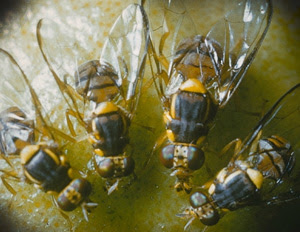
|
Oriental fruit flies have been found in Sacramento, forcing a quarantine.
(Photo courtesy CDFA)
|
Restrictions will keep gardeners from sharing produce
The battle against OFF is on.
Much of the city of Sacramento will be under quarantine for Oriental fruit fly (OFF) after several of the little yellow and black pests were found in local traps.
“It’s one big area,” said Juli Jensen, Sacramento County’s agricultural commissioner. “It covers all of downtown (Sacramento), extends into Yolo County, down to Bartley Cavanaugh Golf Course on Freeport (Boulevard) and over to Bradshaw Road.”
State and county agricultural officials drew up the boundaries for the quarantine area Monday. A map detailing the area is expected to be posted online Tuesday afternoon by the California Department of Food and Agriculture. (Look for it here:
https://www.cdfa.ca.gov/plant/off/regulation.html
) The CDFA oversees the eradication effort.
To be put in place as soon as Tuesday (Aug. 28), that quarantine will stay in effect until these fruit flies are eradicated – an estimated eight months.
During that time, no fruit or vegetables from potential host plants can be moved out of the quarantine area, Jensen said. That affects commercial growers as well as backyard gardeners. More than 125 crops are considered hosts, including grapes, tomatoes, apples, pears, peaches and plums.
“You can’t give it away to people or move it outside the quarantine area,” she said. “I’m worried about our certified producers. They will not be able to sell their tomatoes until after 30 days of treatment, and their tomatoes are ripe now.”
Farmers, distributors and consumers can bring produce into the quarantine area, but growers – commercial or backyard – can’t bring any out.
Keeping the fruit flies isolated is essential to eradication, Jensen noted. Otherwise, the quarantine area will grow and the treatment period lengthen.
“Don’t take fruit off your trees and put it in the green waste,” she said. “That’s really important. You need to keep it on your property. If it’s in the green waste, that just moves the fruit flies around.”
This can be problematic for a lot of gardeners, she added. “I know fruit is falling on the ground right now; what to do with it? We really don’t want people to strip their trees either. If you have fallen fruit, don’t just toss it out. Double bag it, call us and we’ll safely dispose of it.”
The Sacramento County agricultural office can be reached at 916-875-6603.
This is the first OFF infestation in Sacramento County in a decade, Jensen said. The last was in North Highlands.
“The problem with this infestation compared to North Highlands, this area is very rich in hosts,” Jensen said. “There are tons of backyard gardens and fruit trees, so much old citrus all over downtown. It’s kind of a nightmare.”
About the size of a housefly, the Oriental fruit fly is mostly yellow with black markings and clear wings. It looks similar to a cross between a fly and a wasp. Through Monday, 14 have been trapped in Sacramento: 13 males and one female.
“That’s proof we really have a problem – trapping a female,” Jensen said.
The infestation appears centered near Stockton Boulevard and Elder Creek Road/47th Avenue in south Sacramento. Most likely, infected fruit was brought in from Hawaii or Southeast Asia, where Oriental fruit flies are widespread.
“What makes this pest so detrimental: It’s not very picky,” Jensen said. “They like everything.”
With one major exception, she added. “Luckily, strawberries are not a host plant for this fruit fly because the berries are so short-lived, the flies can’t complete their life cycles. So strawberry growers should be OK.”

